December 6, 2005
Mr. Chris Peck and Ms. Jane Roberts
Commercial Appeal
495 Union Ave.
Memphis, TN
Dear Mr. Peck and Ms. Roberts:
It would be nice if the world could be distilled into quick sound bites or short 300 word articles. Unfortunately, that is not the case. The Sunday, December 4, 2005 edition of The Commercial Appeal stated that the December 11 issue would carry another cotton feature article focusing on the disaster that U.S. subsidies present to African cotton farmers. While not having seen the content of the article, the title certainly raises a number of concerns. Chief among those is the over-simplified analysis that focuses on the U.S. cotton program and portrays it as the primary determinant of world prices.
The cotton world is replete with interventions by governments as transparent as the U.S. subsidy programs or hidden like the practices of most Asian countries with tax rebates, non-performing loans and restrictive border measures. It is very simple to obtain U.S. reports of payments to producers and then tout aggregate dollar numbers without any context as to the overall structure of the U.S. farm program.
It takes a solid and sustained effort to uncover and comprehend the insidious web of fiber production and textile manufacturing policies that influence world prices. In particular, China and the Indian subcontinent account for 50% of world cotton production and 60% of world textile and apparel manufacturing. The effective support to Chinese cotton farmers averaged $1 billion in recent years. China is the world’s largest producer of cotton, averaging 25.1 million bales in the last 3 years. Chinese textile manufacturers essentially have a zero cost of capital and a tax rebate system that allows Chinese textile and apparel products to swamp any market with virtually any product. Both the United States and EU concluded bilateral agreements with China to limit the surge in textile products and avoid disruptions of shipments from other countries. In many important cotton product categories, Chinese shipments increased by more than 1,000% with the elimination of textile quotas in 2005.
Add to this scenario the fact that Asian governments subsidized the creation of polyester manufacturing to the point that polyester production has more than doubled in 12 years and more than 75% of the world’s polyester is made in Asia. In 1990, world cotton production was 87 million bales and polyester production was 45 million bales. In 2005, USDA estimates world cotton production at 111 million bales and PCI, Inc. estimates polyester production is 120 million. The added 75 million bales of largely subsidized Asian polyester continue to deny cotton producers everywhere an adequate return on their investment and labor.
It is also important to recognize that the U.S. cotton producer paid for the creation of a research and promotion program that increased U.S. consumer purchases of cotton textiles and apparel from 23 pounds per capita to 35 pounds per capita between 1990 and 2003. The United States added more than 10 million bales of demand to a world market that averaged only 87 million bales during the decade of the ‘90s. During that decade, purchases of cotton products by consumers in the rest of the world declined. If not for the increased purchases of the U.S. consumer, today’s world demand for cotton would be below that of 1990.
Lastly, one of the most brutish facts is that many of the governments in the developing world steal from their own citizens through institutional arrangements that control access to production inputs and market outlets. West African cotton farmers have no choices about from whom they buy inputs or outlets into which they sell their cotton. While a cotton farmer in Brazil or Australia is selling their cotton for 50 cents per pound today, the West African farmer is getting 32 cents per pound.
The United States has cotton subsidies. Some of those subsidies will be eliminated or reduced in the very near future as a result of budget reconciliation now moving through Congress. Further, the U.S. negotiators have tabled a proposal in the Doha Round of world trade talks that would fundamentally affect all aspects of U.S. farm programs and reduce support to the traditional program crops. Additionally, the proposal calls for increased market access for most products in all countries.
These are just some of the issues that must be considered when evaluating world fiber markets and the condition of West African cotton farmers. The National Cotton Council has provided much of this information to your reporters in the past. Regrettably for your readers, it seems to seldom appear in your articles on cotton.
The following pages provide much more background and independently sourced material to support the statements noted above regarding non-U.S. factors in the world cotton market.
Sincerely,
Mark D. Lange, Ph.D.
President and CEO
Internal Issues Limiting Africa’s Cotton Industry
The US cotton program is not the source of economic hardship for farmers in West and Central African countries; rather their continued reliance on a monopolistic, parastatal input supply, ginning and marketing system. While this system was originally designed to provide a fully integrated supply and marketing chain and provide for vital support services, such as research, extension and infrastructure, the system now fails to serve the best interests of the farmers and does not provide competitive markets for their cotton production.
An April 15, 2005 CATO Institute report Underdevelopment in Sub-Saharan Africa: The Role of the Private Sector and Political Elites concluded the following:
“Entrepreneurs in Africa, however, face daunting constraints. They are prevented from creating wealth by predatory political elites that control the state. African political elites use marketing boards and taxation to divert agricultural savings to finance their own consumption and to strengthen the repressive apparatus of the state.”
“Peasants must also be given direct access to world markets. They must be able to auction their cash crops, including coffee, tea, cotton, sugar, cocoa, and rubber, freely rather than being forced to sell them to state-controlled marketing boards at discounted prices.”
The system that takes up the West African cotton farmers’ production also provides the inputs at inflated prices. Source: UNCTAD, INFOCOMM, Market Information in the Commodities Area, Cotton, Marketing Chain.
- The USAID and USDA/FAS teams visiting West Africa in Fall 2004 with NCC representatives found fertilizer prices double the cost of the same fertilizer product in the U.S. market.
- Additionally, the team discovered that farmers often divert inputs intended for their cotton crop to their feed crops, as the parastatal system for cotton is the only reliable source of all crop inputs. The end result is lower cotton yields with which to pay back the cost of the inputs, furthering the financial strain on an already fragile system.
West African cotton farmers in the Nov. 28, 2005 TIME magazine article noted the expensive and poor quality cottonseed for planting they are forced to use.
- Cottonseed is delivered to West African farmers by the same enterprises that take up the picked cotton at year end. No competition for raw cotton means no competition for seed delivery with resulting declines in yield and quality.
- The TIME article further notes in 2003 when the world price was almost 70 cents the West African farmer received 42 cents. Today, when the world price is 60 cents, the West African farmer nets only 32 cents per pound. That spread is completely the result of the marketing institutions in West Africa. Their cotton producing counterparts in Brazil and Australia are netting 15 to 20 cents more per pound.
The result of significantly lower prices than their international counterparts coupled with tremendously higher input prices is net incomes for African cotton farmers that are far below reasonable expectations.
Recent exchange rate movements have contributed to African cotton’s economic difficulties by increasing costs of production. In a January ’05 report by ICAC, analysts concluded that the strength of the euro has increased the costs of production for African cotton farmers.
The West African franc is pegged to the euro. As the euro strengthens relative to the dollar, so does the franc. West African producers purchase inputs in francs. The ICAC economist concluded “The fall of the US dollar against the euro impacts heavily on production costs expressed in CFA francs. All other things being equal, the average production cost of cotton in the Franc Zone, placed at importing ports, has risen from the equivalent of less than 50 cent per lb in 2001/ 02, to more than 70 cents per lb in 2004/05.”
It is also the case that the demise of Europe’s textile industry has had a significant impact on West African cotton farmers. West Africa has traditionally been a significant supplier of raw fiber to the textile industries in the European Union. In recent years, with the decline of the EU’s textile sector and the emergence of increased cotton processing in China, India and Pakistan, trader patterns have shifted. West Africa no longer maintains the same location advantage relative to Asian markets as compared to the European market.
Retail Demand for Cotton Textile and Apparel Products
Competition from Synthetic Fibers
Since 1990, cotton has steadily lost ground to synthetic fibers. With consumption in excess of the equivalent of 170 million bales of cotton, synthetic fiber is challenging cotton in every market. While cotton consumption struggled with growth of less than 1.5 percent during the 1990s and early 2000s, synthetic fiber enjoyed growth of almost five percent per year. Even more striking is the double-digit growth rates for synthetic fiber seen in China, India and other parts of Asia where growth has been spurred by tax waivers, rebates on import duties, elimination of income and sales taxes, assurances of energy supplies and other incentives.
The world’s capacity to produce chemical fiber grew by almost nine percent annually during the 1990s. In China, the growth was double that rate, at an astounding 18 percent. In fact, between 1993 and 2002 the countries of Asia added more capacity for the production of chemical fiber than existed in the world in 1990.
Between 1990 and 2003, the growth in final consumer demand for cotton products barely kept pace with population (Exhibit 1). While per-capita retail consumption of synthetic fiber textile products increased 3.7 pounds over this 13-year period, per-capita retail consumption of cotton textile products increased just 0.1 of a pound. As a result, cotton’s share of retail fiber consumption fell from 46.9 percent to 37.9 percent.
If cotton had retained its 1990 market share, total world cotton consumption in 2003 would have been 26 million bales above the actual level. An additional 26 million bales of demand represents a 25% increase in the size of the world cotton market.
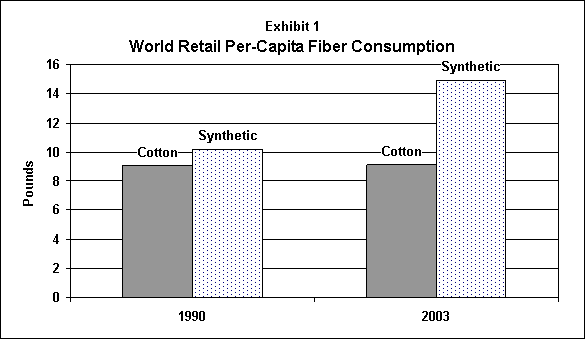
The United States has Driven World Demand for Cotton Products
The United States is one of the few countries that saw an increase in per capita retail consumption of cotton between 1990 and 2003 and is the only country in which cotton increased its share of the total retail fiber market. The average consumer in the United States buys more cotton textile and apparel products than any other consumer in the world. In 1990, the average per-capita retail consumption of cotton products in the United States was 23.4 pounds. By 2003, the number had grown to 35 pounds per capita.
Conversely, the per capita consumption of cotton products at the retail level fell between 1990 and 2003 in many countries - even countries that are significant producers of cotton and cotton textiles. Outside of the U.S., per capita purchases of cotton fell from 7 pounds in 1990 to 6 pounds in 2003 (Exhibit 2).
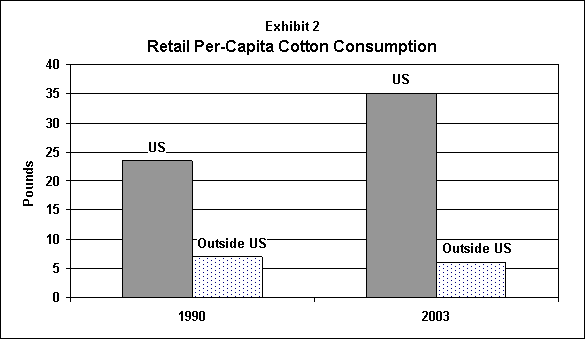
Chinese consumption of cotton products fell from 6.9 pounds per capita in 1990 to 5.3 pounds per capita in 2003. At the same time, the purchases of synthetic fiber products grew from 5.3 pounds per-capita to 18.4 pounds per-capita.
- If China had maintained its per-capita cotton consumption at the 1990 level, the 1.2 billion consumers in China would be purchasing an additional 4.4 million bales of cotton per year.
- Although Japan’s per-capita income is above the US, its cotton consumption is only one-half the level of the US.
- Per capita consumption of cotton products in Western Europe is 19 pounds less than in the US.
- If consumers in Japan and Western Europe consumed at the same level as in the US, it would mean an additional demand of 20 million bales.
Over the past 5 years, the United States has consumed 12 million more bales than it produced. The International Cotton Advisory Committee (the ICAC) has recognized the strength of consumption patterns in the United States:
In contrast, end-use cotton consumption in industrial countries accounted for 48% of world consumption in 1998 and 44% in 2003. Only in the USA and Canada did end-use cotton consumption increase, rising by half a million tons during the five-year period, while small declines were registered in the remaining industrial countries.[1]
Growing cotton consumption in the United States did not happen by accident. The United States has a mature, longstanding research and promotion program that is funded by U.S. cotton producers and by assessments on the cotton content of imported cotton textile products. Contributions to cotton demand made by these research and promotion programs are widely acknowledged.
Research and promotion have also supported cotton consumption. Research by the Secretariat suggests that as a result of research and promotion 300,000 tons more of cotton have been consumed since 1998.[2]
Recent criticisms of U.S. cotton production conveniently take this well-developed cotton apparel market as a given, ignoring the substantial time, effort and funding devoted by the United States cotton producer to nurturing market growth.
Cotton Yield Growth and Technology Adoption
Between 1995 and 2004, average world yields increased roughly 140 pounds per acre from 506 pounds to 645. That would suggest that yields have increased about 14 pounds per year over the last ten years. That is nearly double the rate yields increased between crop years 1960 and 1994 when average world yields increased 247 pounds per acre from 272 pounds to 520 pounds. The increases in yields have been most dramatic in the several leading cotton producing countries.
Between 1995 and 2004, China experienced increases of over 200 pounds. India has seen an increase in excess of 100 pounds, and in the United States, yields have gone from 537 pounds per harvested acre to more than 850 pounds. In Brazil, the increase has even been more astounding as yields have been increasing at an average rate 92 pounds per acre over the past decade (Exhibit 1). Over that same time frame, average yields in the four cotton-producing countries known as the African C-4 (Benin, Burkina Faso, Chad and Mali) have not increased. In fact, yields have exhibited a downward trend over the 1995-2004 period with the average decline of approximately 3 pounds per acre.
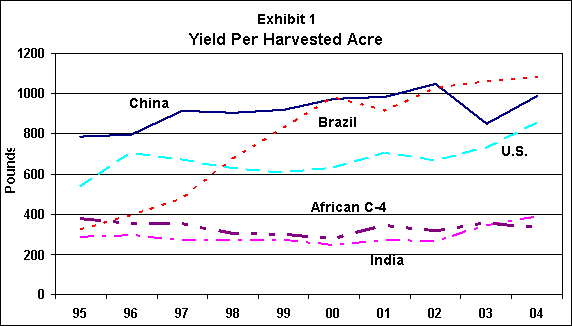
The net result of these differing yield trends is a substantial change in the relative competitive positions of the major cotton-producing countries. For example, if the world price of cotton was $0.60 per pound, then an average acre of cotton in Brazil in 1995 would be worth $194. By 2005, the revenue from an acre of Brazilian cotton would increase to $649 based on historical yield growth and assuming a constant price of $0.60 per pound. In the African C-4 countries, the cotton produced from an average acre in 1995 would be worth $225 on the world market. By 2004, the average acre would now generate only $198 with the lower yields.
While favorable weather has played a part in the increased yields, it was not the only contributing factor. Continued improvements in transgenic varieties have played an increasing role in gains in yield and improved fiber qualities. Key cotton producing countries where transgenic varieties are now grown include China, India, Australia, Argentina, Mexico, South Africa, and the United States. Since its introduction in 1996, production of transgenic cotton has been one of the most rapidly adopted technologies ever. The International Service for the Acquisition of Agri-biotech Applications (ISAAA) estimates that 20% of global cotton area was planted to transgenic varieties (herbicide tolerant or insect resistant or both) in 2002, up from almost none in 1996. Transgenic varieties accounted for about 80% of upland cotton planted in the United States in 2004.
As a result of the increased yields over the last decade, world cotton production has reached an all time high. World cotton production has grown over 25 million bales from 94 million bales in 1995 to an estimated 119 million bales in 2004. Again, the greatest gains can be seen in the leading cotton producing countries. Since 1995, cotton production has increased in China, India, Pakistan, and the United States. Combined production in these countries will account for 70% of the 2004 cotton crop if current estimates are reached. The greatest gains in production have been made in China where production rose nearly 7 million bales between 1995 and 2004. As world cotton production has increased, cotton prices have fallen. For the 1995 crop year, the “A” Index (a proxy for the world price of cotton) averaged 85.61 cents per pound. For the 2004 crop year, the “A” Index has ranged between 48 and 59 cents per pound. The increase in world production due to increasing yields continues to put downward pressure on cotton prices (Exhibit 2).
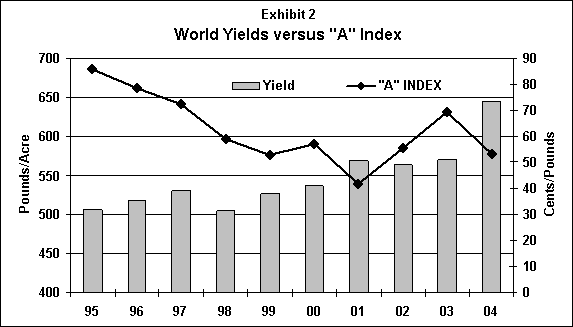
Analysis of Impacts of US Cotton Program on World Price
There are various analyses that attempt to estimate the impacts of the US cotton program through the use of economic models, using counterfactual analysis. One of the more relevant premises is that acreage (or production) decisions are affected by expected incentives offered by government programs. A counterfactual analysis suggests that removal of the program would ensure that acreage decisions are determined by the market, showing what the market situation would have been like without the US program.
The magnitude of these impacts depends on the amount by which countries respond to the change brought about by the removal of the US program.
The Brazil panel concluded that the presence of certain aspects of the US program caused serious prejudice through significant price suppression to the interests of Brazil, but never made a finding as to the degree which the US program suppressed world prices, except to say it was not “insignificant.”
Africa countries and Oxfam and others have claimed that the US program reduces world prices as much as 15%. Daniel Sumner claimed a 13% reduction in his analysis conducted for Brazil.
These claims are exaggerated; have not been accepted officially, and have been repeatedly undermined by subsequent, more independent analysis.
Africa has claimed annual damage of $300 million caused by the US program. Even if a 15% price impact is assumed, this figure is overstated by almost $100 million. Recent studies suggest that, at most, world price impacts may have affected African cotton revenue by $41 million annually.
Quantifying Impacts
Results of 11 studies are shown in the following chart. The price impacts range from a low of 2% to a high of 12.6%. In fact of the 11 studies, only 2 results are above 10% -- the ICAC model and the Sumner model prepared for Brazil as part of the WTO case.
The ICAC work has been widely criticized by both the FAO and Shepherd studies. Their reviews raise serious concerns about both methodology and model response. Furthermore, recent statements by ICAC staff have suggested that after an initial adjustment period, they now expect little in the way of improved world prices of cotton as a result of eliminating US programs.
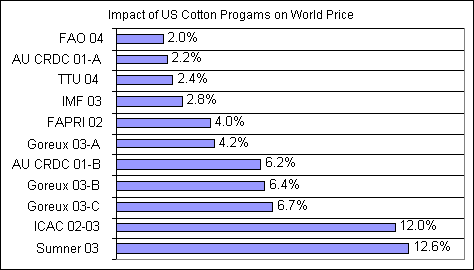
Sumner’s result of 12.6% reflects his analysis of the impacts of eliminating all forms of support related to cotton. However, he also published the impacts associated with each component. For example, the marketing loan accounts for 5.8% of impact on world price or almost one-half of the total.
However, the panel rejected the argument that PFC/DP payments and crop insurance contributed to price suppression. In addition, the panel did not attribute price suppression to the export credit guarantee programs. Excluding these three components from Sumner’s analysis brings the total impact down to 9.4%. The world price impact of 9.4% is the amount attributed to the marketing loan, Step 2, market loss assistance and counter-cyclical payments.
The impact attributed to MLA/CCP’s reflects Sumner’s assumption that farmers expect to be able to update bases on a relatively frequent basis in the future. However, the panel rejected this logic, and invalidated the magnitude of Sumner’s acreage impact due to MLA/CCP’s. This further reduces the total impact by 0.6%.
The remaining impact of 8.8% reflects the marketing loan and Step 2. Regarding Step 2, legislative action has been taken by Congress to end the Step 2 program. For purposes of determining economic injury, the 3% price impact attributed to Step 2 should not be included.
The relevant impact is now the one associated with the marketing loan program. Sumner estimates that removal of the marketing loan would increase world cotton prices by an average of 5.8%. These results are now much more in line with the vast majority of other studies and leave only the ICAC work as an outlier.

